Children are 91% more likely than adults to sustain a head injury while sledding
Concussions and closed-head injuries in children were the most commonly reported sledding-related injury from 2008 to 2017, according to published results.
Researchers from The Ohio State University used data from the National Electronic Injury Surveillance System to perform a retrospective analysis of 220,488 patients who were treated in the emergency department for injuries sustained on sleds (n = 1,217), toboggans (n = 1,273), snow disks (n = 1,274) and snow tubes (n = 1,299).

Study data showed that during the period of January 2008 to December 2017, the overall rate of reported sledding-related injuries decreased by 52.5%. The researchers also noted that children accounted for 69.7% of all injuries, and the average rate of injury was 6.74 times higher in children than adults.
“Compared to adults, children were 91% more likely to sustain an injury to the head and were 58% more likely to be diagnosed with a concussion or closed-head injury (CHI),” the researchers wrote.
Children also accounted for 81.6% of all head injuries and 78.4% of all CHIs. Snow tube and disk riders were the most likely to sustain a head injury, and 63.2% of injuries involved a collision, the researchers added.
“Although sledding-related injuries decreased over the study period, more research and education to prevent these injuries is needed,” they wrote. “The injury patterns and risk of injury type differed by age, with more head injuries sustained by children. Sledding should be performed in obstacle-free areas to reduce the risk of collision and while wearing helmets to mitigate head injuries.”
